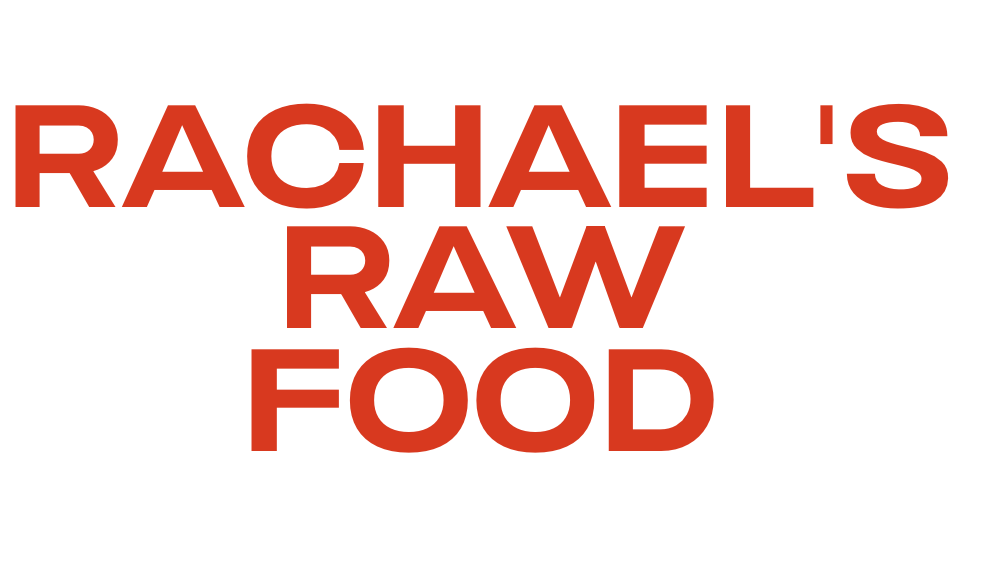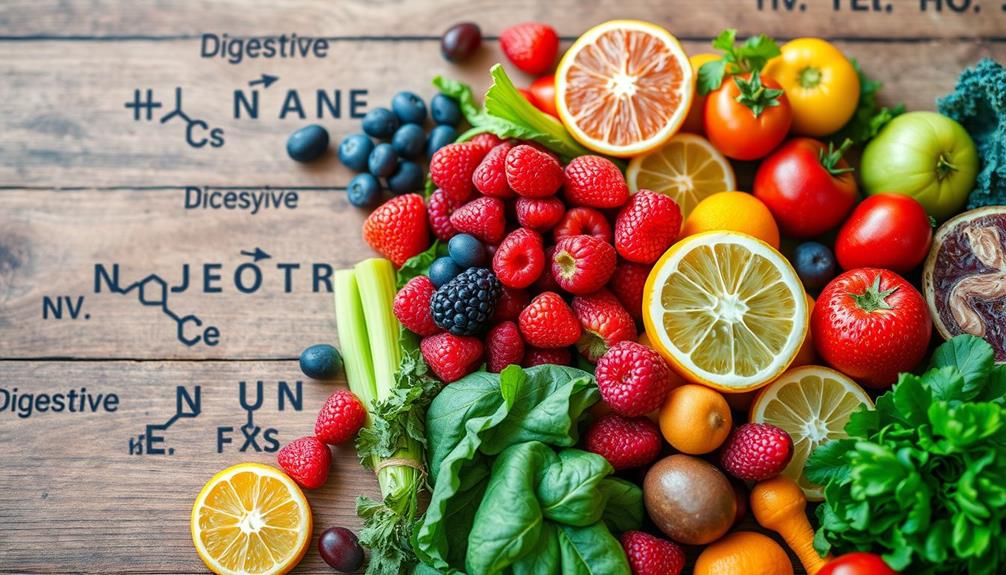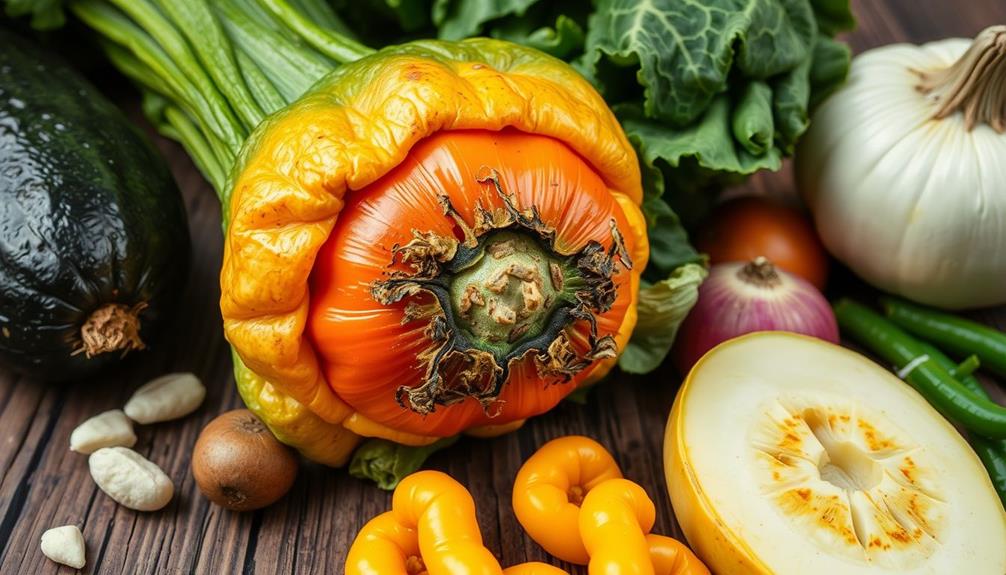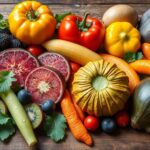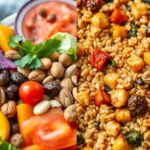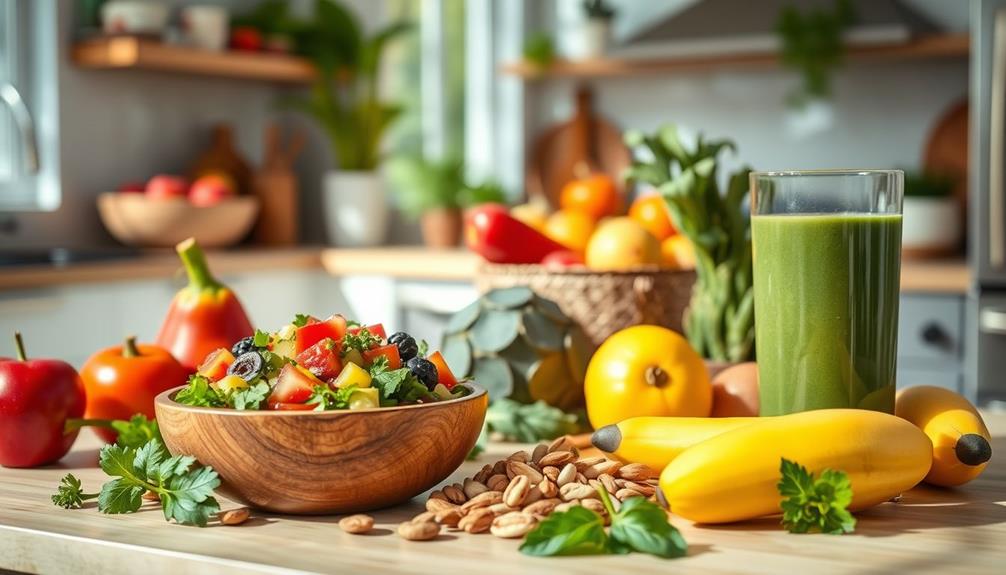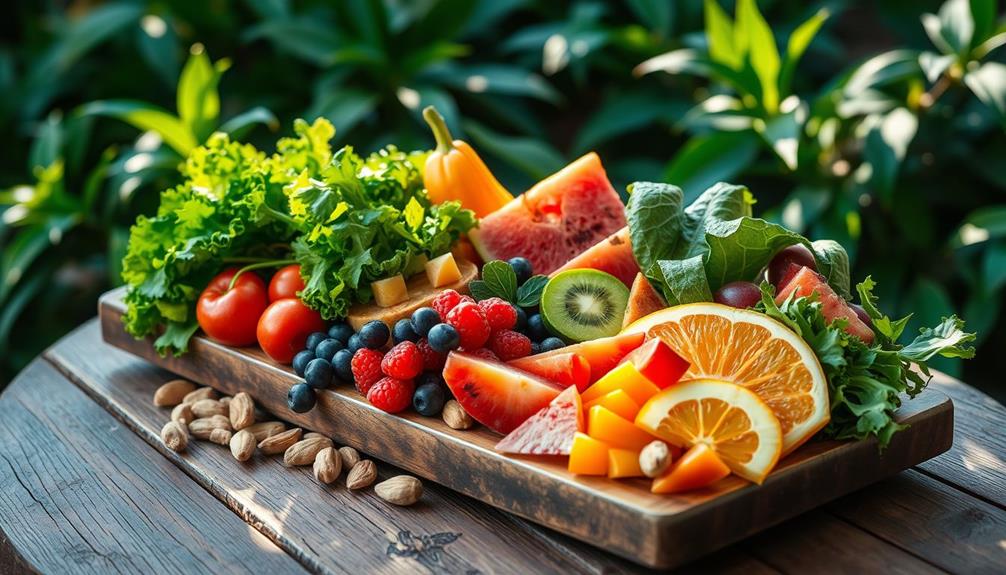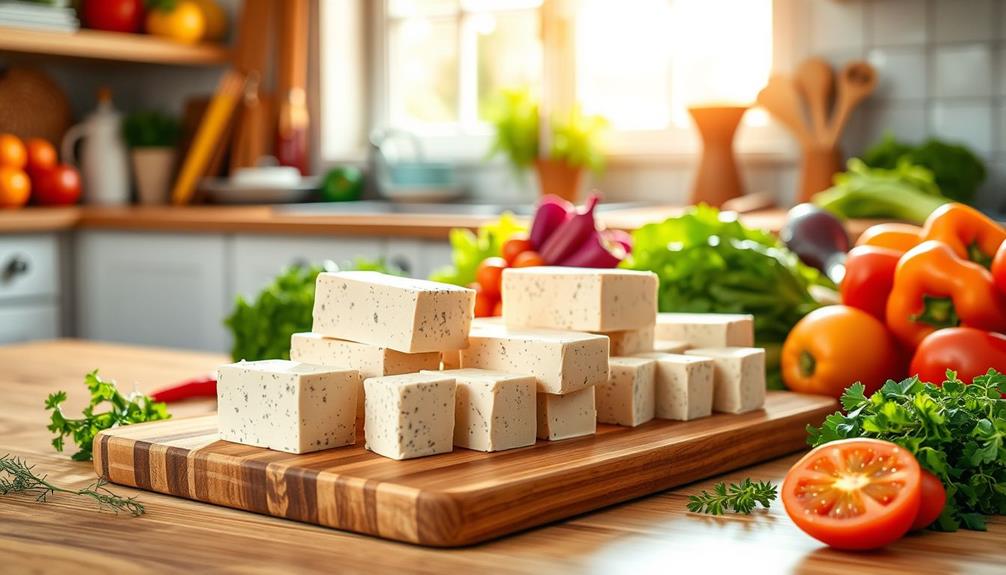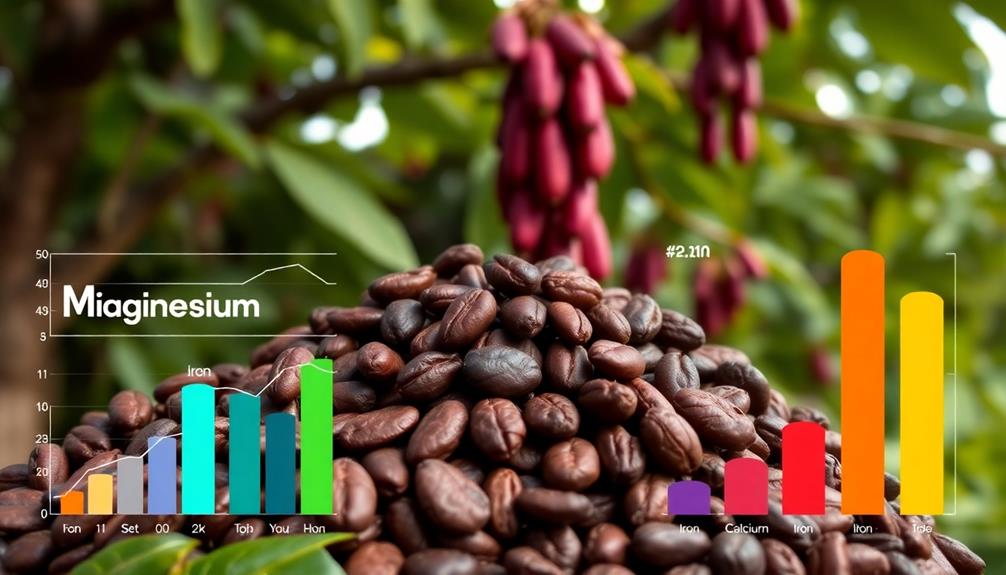Raw food can be hard to digest for many people. Its high fiber content and intact cell walls can lead to gas and bloating. If your digestive system isn't producing enough enzymes, you might feel discomfort after eating raw foods. Individual gut health plays a big role in how you react to raw versus cooked foods. Some may thrive on raw diets, while others experience symptoms like bloating. It's important to monitor your body's responses to identify any digestive issues. If you're curious about how to balance raw and cooked foods for ideal health, there's plenty more to explore.
Key Takeaways
- Raw foods can cause gas and bloating due to high fiber content and intact cell walls, making them harder to digest for some individuals.
- Compromised digestive function may lead to insufficient enzyme production, resulting in discomfort after consuming raw foods.
- Individual microbiome variations affect how well one can digest raw versus cooked foods, with some people experiencing greater difficulties.
- High intake of raw foods may negatively impact gut health, especially in cases of dysbiosis or underlying digestive issues like SIBO.
- Cooking foods enhances digestibility by breaking down fibers and reducing anti-nutrient content, improving overall nutrient absorption.
Understanding Digestive Challenges
When you immerse yourself in raw foods, you might encounter some digestive challenges. Raw foods, especially fibrous fruits and vegetables, can be tougher to digest due to their intact cell walls and higher fiber content. This can lead to gas and bloating, particularly if your gut microbiome isn't well-equipped to handle such foods.
Additionally, understanding the significance of gout nutrition can provide insights into how dietary adjustments may alleviate some digestive discomfort.
If you have a compromised digestive function or gut infections, your body may struggle to produce enough digestive enzymes, making it even harder to break down and absorb raw foods. You might notice discomfort after eating these foods, signaling that something needs attention regarding your digestive health.
Monitoring your reactions to raw foods is vital. If you find that they exacerbate your symptoms, it could indicate underlying issues with your gut microbiome.
While cooking food can considerably enhance nutrient absorption by breaking down complex structures, it's important to recognize that not everyone thrives on a raw diet. Ultimately, understanding these digestive challenges can help you make informed choices about incorporating raw foods into your meals.
Raw Vs. Cooked Nutritional Benefits
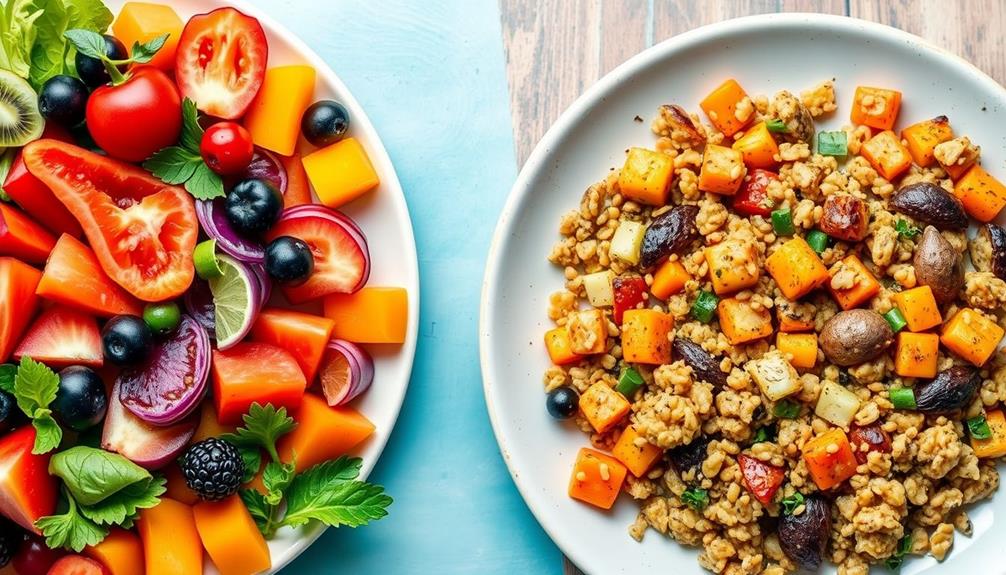
While both raw and cooked foods offer unique nutritional benefits, understanding the differences can help you make better dietary choices. Raw foods typically retain higher levels of certain vitamins, like vitamin C, and enzymes that can be destroyed during the cooking process. However, cooking can enhance nutrient absorption of antioxidants such as beta-carotene and lycopene, making them easier for your body to utilize.
Here's a quick comparison of the nutritional benefits of raw versus cooked foods:
| Nutrient Type | Raw Foods | Cooked Foods |
|---|---|---|
| Vitamins | Higher in vitamin C | More bioavailable antioxidants |
| Enzymes | Retains natural enzymes | Enzymes are mostly destroyed |
| Digestibility | May cause digestive issues | Improved nutrient absorption |
| Beneficial Compounds | More potent in broccoli and garlic | Enhanced in spinach and tomatoes |
| Cooking Methods | N/A | Steaming preserves more nutrients |
Ultimately, the best approach often involves a balance of both raw and cooked foods, allowing you to take advantage of their distinct benefits while minimizing any potential digestive issues.
Impact on Gut Microbiome
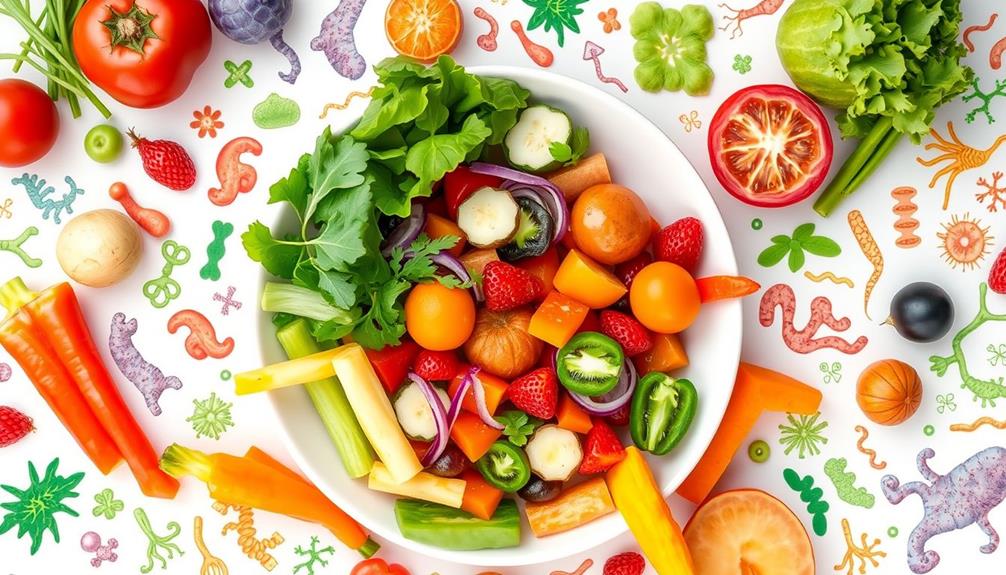
When you choose raw foods, you might notice an impact on your gut microbiome that differs from cooked options.
Studies show that raw diets can lead to less bacterial diversity, which could affect how your body processes these foods.
Additionally, consuming raw foods like celery juice, which is known for its anti-inflammatory properties, may influence gut health positively.
Since everyone's microbiome is unique, your individual response to raw versus cooked foods can vary considerably.
Gut Bacterial Diversity
Gut bacterial diversity plays an essential role in your overall digestive health and well-being. When you consume a diet high in raw foods, studies indicate that it can negatively impact your gut health. For instance, research shows that raw sweet potatoes hindered bacterial diversity in mice, while cooked versions supported a healthier gut environment. This suggests that cooking can enhance digestion by breaking down fibers, making nutrients easier to absorb.
Additionally, key domains of development in psychology highlight how environmental interactions, such as dietary choices, shape individual health outcomes.
Your individual gut microbiome greatly influences how well you tolerate and process raw versus cooked foods. While increased fiber intake from raw foods can benefit gut health, it might also lead to digestive discomfort, especially if you have existing gut infections or imbalances.
In contrast, processed foods often lack the beneficial nutrients found in raw or cooked options, which further complicates the quest for ideal bacterial diversity.
To foster a thriving gut microbiome, you might consider balancing raw foods with cooked ones. This approach not only enhances bacterial diversity but also promotes better digestion and nutrient absorption, ensuring your gut remains healthy and resilient.
Raw Vs. Cooked Effects
Here is the revised MY ARTICLE SUBHEADING CONTENT:
Throughout history, the way we prepare our food has considerably influenced our digestive health, particularly regarding the gut microbiome. Research indicates that raw foods, while rich in fiber, can negatively impact gut microbiota diversity and lead to digestive issues, similar to how individuals with BPD may experience chronic feelings of emptiness and instability in their self-image, affecting their relationship with food.
In contrast, cooked foods often enhance nutrient absorption and promote a healthier gut environment, paralleling the importance of emotional regulation in maintaining overall well-being the impact of emotional dysregulation.
Here are three emotional impacts of choosing between raw and cooked foods:
- Frustration: Struggling with digestive discomfort due to raw food might leave you feeling defeated.
- Empowerment: Discovering that cooked foods can improve nutrient absorption empowers you to make informed dietary choices.
- Hope: Understanding that cooking can foster a healthier gut microbiome provides hope for better digestive health.
Cooking breaks down fibers, making it easier for your body to digest and absorb essential nutrients.
Studies show that cooked sweet potatoes, for instance, support a more favorable gut environment compared to their raw counterparts.
By opting for cooked foods, you might enhance your digestive health and support a thriving gut microbiota.
Individual Microbiome Variability
Variability in individual microbiomes plays an essential role in how your body digests raw foods. Your unique gut bacteria can greatly influence fiber breakdown and nutrient absorption, meaning that not everyone processes raw foods the same way. Some people might struggle with digestion due to lower levels of specific enzymes produced by their gut bacteria, leading to uncomfortable symptoms like gas and bloating.
Additionally, certain natural remedies, such as essential oils for digestive support, can further aid in promoting a healthy gut environment.
The diversity and health of your gut microbiome determine your tolerance for raw foods. If your microbiota is balanced, you're likely to experience better digestion. However, if you have dysbiosis—a condition characterized by an imbalance in gut bacteria—you might find raw foods particularly challenging, exacerbating digestive issues and discomfort.
To optimize your digestion and overall health when consuming raw foods, consider personalized dietary approaches that take your individual microbiome variability into account.
Food Safety Concerns
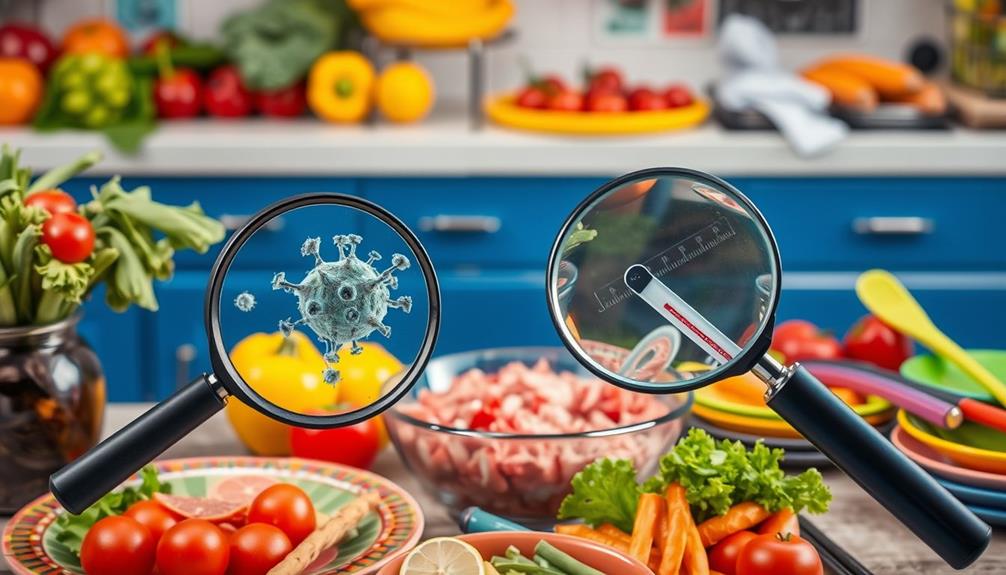
When you choose raw foods, it's essential to be aware of the potential pathogen risks, like E. coli and Salmonella, that can lurk in uncooked items.
Understanding the importance of proper diet and food safety for pets, like hamsters, can also apply to human food choices as hamster care involves safe snacks that are free from harmful pathogens.
Practicing safe food handling, such as washing fruits and vegetables thoroughly, can greatly reduce the chances of foodborne illnesses.
Pathogen Risks in Raw Foods
Raw foods can pose significant pathogen risks, especially when it comes to raw meats like beef and poultry. Harmful bacteria such as E. coli and Salmonella thrive in these foods, leading to serious foodborne illnesses if you don't practice proper food handling.
While raw fruits and vegetables are generally safe, they can still harbor contaminants, particularly spinach, lettuce, and sprouts. According to research, mammography aims to detect breast cancer early for better treatment outcomes, highlighting the importance of recognizing health risks in various forms.
Here are three major concerns to take into account:
- Foodborne Illness Outbreaks: Many outbreaks stem from contaminated raw foods.
- High-Risk Populations: Children, seniors, pregnant women, and the immunocompromised are especially vulnerable.
- Unseen Consequences: Even a minor infection can lead to severe health issues for sensitive individuals.
To minimize these risks, you should be aware of safe consumption practices. Public health recommendations advise high-risk populations to avoid raw foods altogether, as their immunity may not withstand harmful pathogens.
Safe Food Handling Practices
Understanding the risks associated with consuming raw foods highlights the importance of safe food handling practices. To minimize the chance of foodborne illness, you should start with thorough handwashing before and after handling raw foods. This simple step can greatly reduce the risk of pathogens like E. coli and Salmonella, which can impact your health and financial well-being if medical expenses arise from foodborne illnesses.
Additionally, implementing a sound budget can help manage any unexpected costs related to health issues, as maintaining good health is an essential part of a thorough financial health strategy.
Next, it's important to prevent cross-contamination. Always separate raw foods, especially raw meat, from cooked foods during preparation. This separation guarantees that harmful bacteria don't transfer to items that won't be cooked further.
When you're ready to cook, remember that proper cooking temperatures are essential. For instance, poultry should reach an internal temperature of at least 165°F (74°C) to eliminate dangerous pathogens.
Additionally, utilize safe storage methods for your raw foods. Refrigerate them promptly and keep them at safe temperatures, ideally below 40°F (4°C), to inhibit bacterial growth.
Cooking Methods and Nutrient Retention
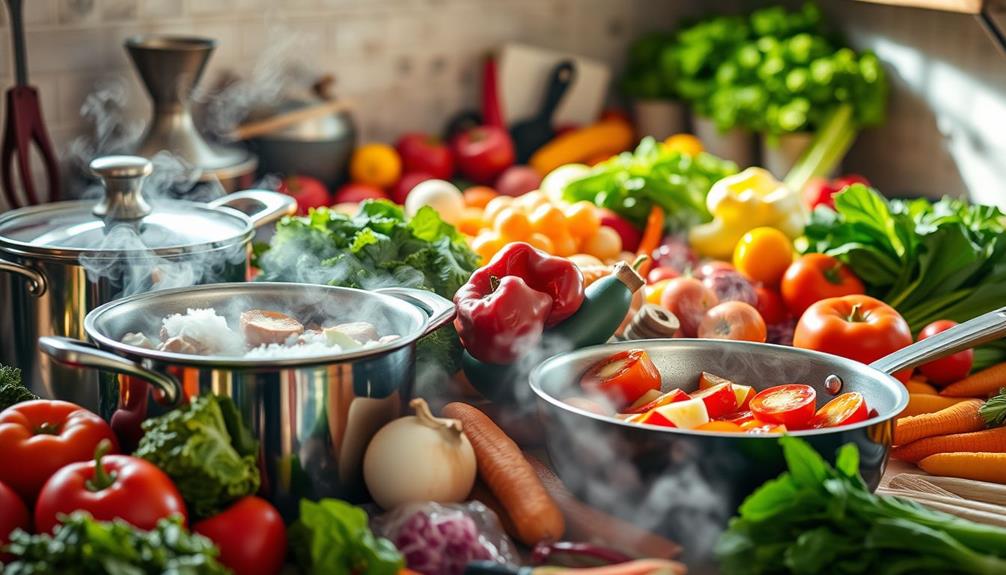
Nutrient retention during cooking is vital for maximizing the health benefits of your food. Cooking methods can greatly impact how much nutrition you get from your meals. For instance, while raw food diets emphasize eating uncooked produce, certain cooking techniques can enhance both digestibility and nutrient absorption.
Understanding the mechanics of cooking methods can elevate your meals, much like how different brewing methods affect caffeine levels in coffee.
Consider these points when choosing your cooking methods:
- Steaming and stir-frying preserve nutrients effectively, keeping your meals vibrant and nutritious.
- Boiling, on the other hand, can reduce water-soluble vitamins by 50-60%, so it's best to avoid this method for nutrient-dense foods.
- Cooking grains and legumes reduces anti-nutrient content, making them easier to digest and more beneficial for your body.
When you cook foods like tomatoes, you actually increase levels of antioxidants like lycopene, which may lower heart disease risk.
Personal Health Experiences
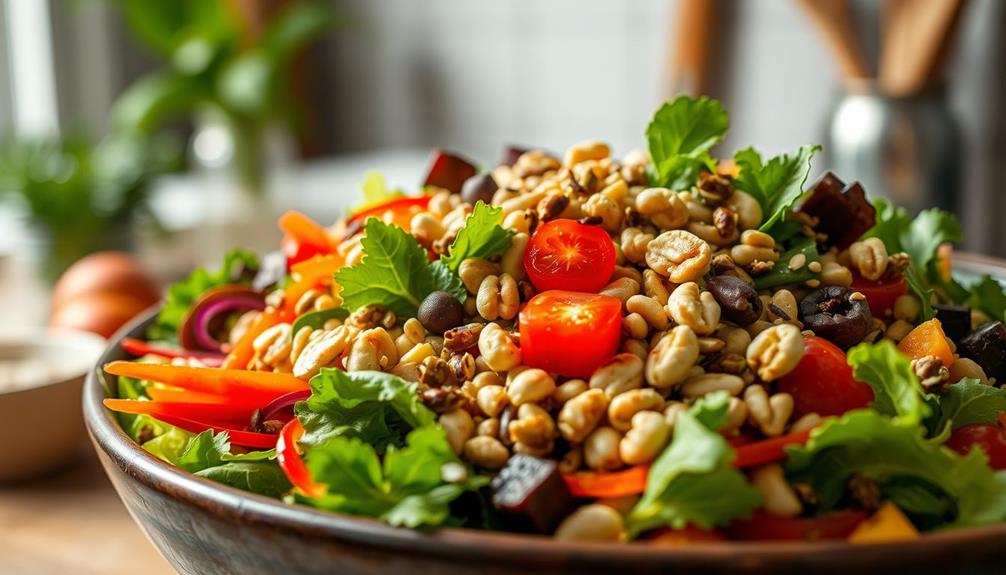
Cooking methods can greatly influence how your body responds to different foods, especially when it comes to personal health experiences. For many, raw foods can trigger digestive issues, particularly if you struggle with conditions like IBS. The high fiber content and complex structures in raw foods may exacerbate symptoms such as gas and bloating. If you have hidden gut infections, these raw options could be even more challenging, as they can hinder enzyme production.
To give you a clearer picture, here's a table summarizing common reactions to raw foods:
| Experience | Cause | Possible Outcome |
|---|---|---|
| Extreme Bloating | High fiber content | Discomfort |
| Undigested Food | Gut infections | Nutrient deficiencies |
| Increased Gas | Complex food structures | Digestive distress |
| Symptoms Exacerbation | Pre-existing digestive issues | Confusion about health status |
| Individual Variation | Unique gut microbiome | Different reactions |
Monitoring your individual reactions to raw foods is essential. Your unique gut microbiome and overall digestive health will determine how you respond, so listen to your body!
Role of Fermented Foods
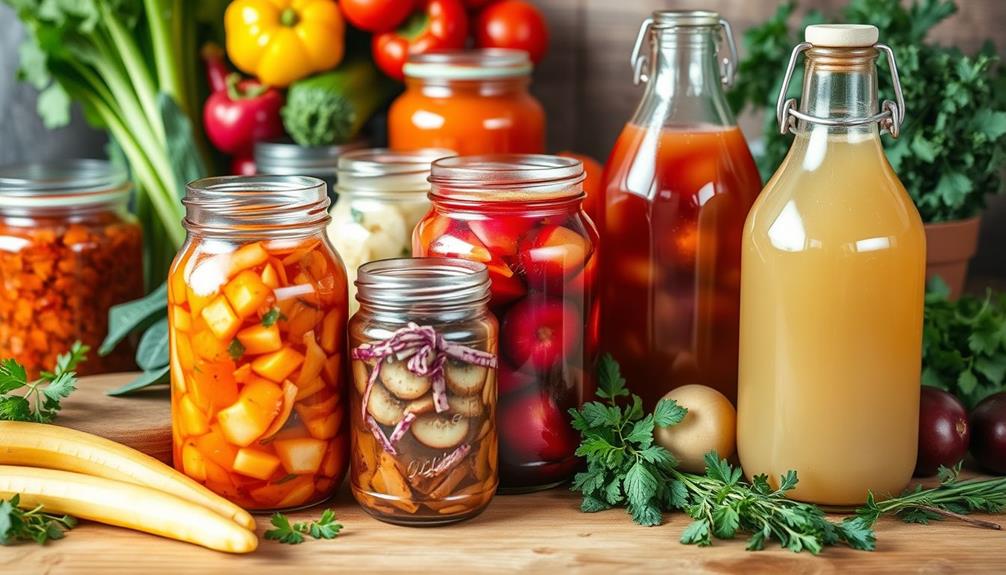
Fermented foods play a significant role in gut health, offering benefits like enhanced digestion and improved nutrient absorption. They can also promote a balanced microbiome, much like how glycolic acid aids in scalp care by reducing buildup and enhancing health.
However, they can also lead to uncomfortable digestive symptoms, especially if you're dealing with certain gut issues. If you're curious about incorporating these foods into your raw diet, you should be aware of their potential downsides:
- Bloating and gas – Fermented foods can cause extreme discomfort, making you feel like you're swollen and full.
- Worsening existing conditions – If you have conditions like Small Intestinal Bacterial Overgrowth (SIBO), these foods may aggravate your symptoms.
- Hidden gut infections – Fermented items mightn't sit well with your digestive system if you have undiagnosed infections.
While fermented foods like yogurt, kimchi, and sauerkraut can be beneficial for promoting gut health and feeding beneficial bacteria, you need to monitor how your body reacts.
If you experience discomfort, it's essential to approach these foods cautiously. Listening to your body can help you determine what works best for your gut health without exacerbating any digestive symptoms.
Satiety and Weight Management
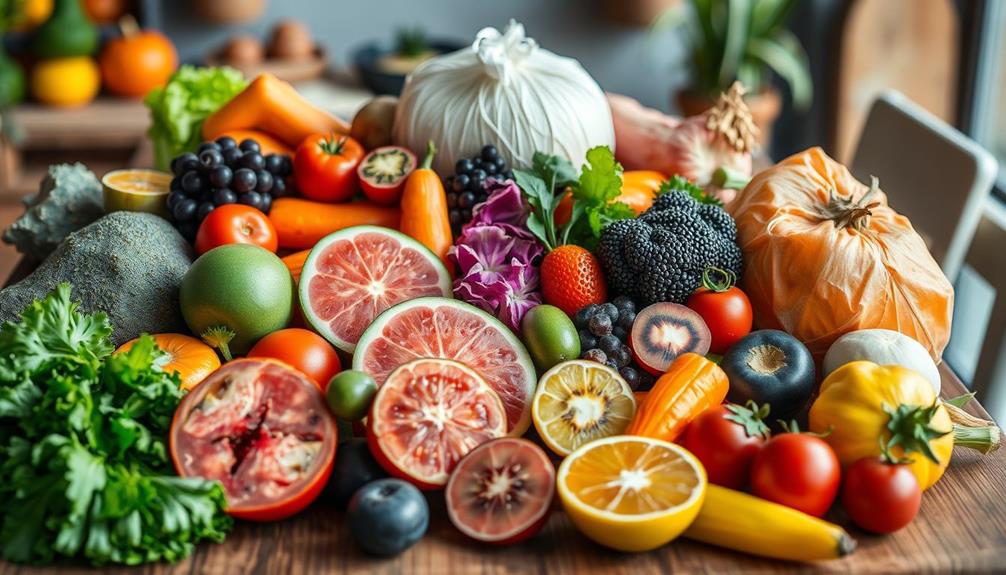
Eating raw foods can greatly impact your feelings of fullness and weight management. The high fiber content in raw foods often promotes satiety, making you feel fuller for longer. However, this same fiber can cause digestive issues for some, leading to gas and bloating, especially if your body struggles to break it down effectively.
While raw foods might help you lower your calorie intake, they often require more chewing and digestive effort, which can either enhance your fullness signals or create discomfort.
In contrast, cooked foods usually have a higher energy density, which can lead to increased satiety and allow for smaller portion sizes—this can aid your weight management efforts.
To optimize satiety and overall dietary satisfaction, consider a balanced diet that includes both raw and cooked foods. This approach can help you enjoy the benefits of raw foods while minimizing potential digestive issues.
Ultimately, understanding how raw foods affect your satiety can be an essential part of your weight management strategy, especially if you're looking to maintain a healthy balance without sacrificing comfort.
Holistic Approaches to Health
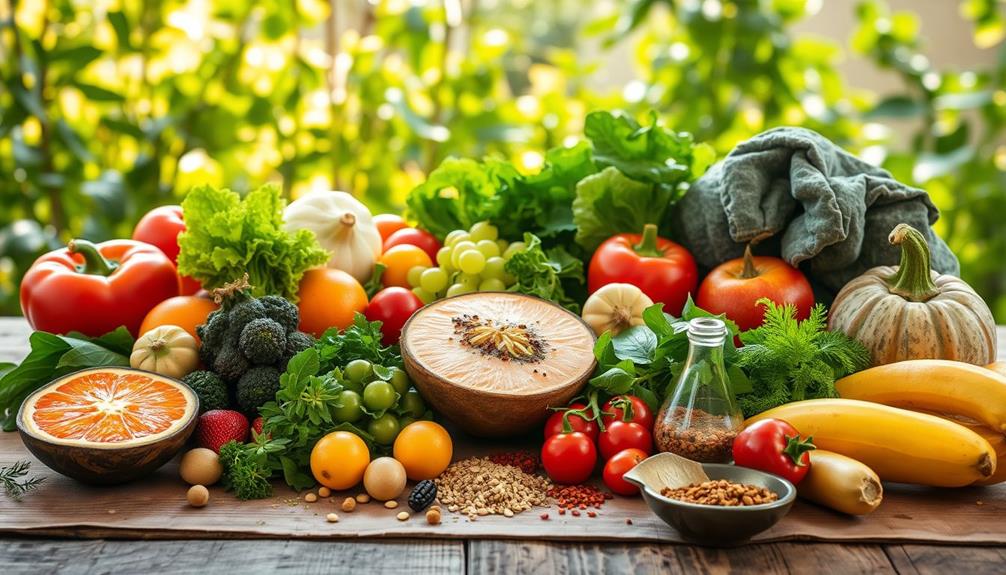
Recognizing the interconnectedness of body systems is key to adopting holistic approaches to health. Your gut health plays a vital role in how well you digest both raw and cooked foods. By understanding your microbiome, you can tailor your diet for better digestive health.
Here are three important considerations:
- Address underlying gut issues: Infections like SIBO or parasites can hinder your ability to process foods. Treating these is essential for improving your overall digestion.
- Incorporate fermented foods mindfully: While they can boost gut health, be cautious. They might worsen symptoms if you already have digestive problems.
- Opt for a balanced diet: Combining raw and cooked foods maximizes nutrient absorption. Cooking breaks down fiber, enhancing digestibility, especially for certain foods.
To truly optimize your gut health, consider functional lab testing. This can help identify hidden issues, allowing you to create a personalized holistic approach to healing that goes beyond just diet.
Embrace the complexity of your body's systems to reveal improved digestive health and overall well-being.
Frequently Asked Questions
What Do Doctors Say About the Raw Food Diet?
Doctors often express concerns about the raw food diet, highlighting potential nutrient deficiencies, risks of foodborne illnesses, and digestive challenges. They recommend consulting a registered dietitian to guarantee you meet your nutritional needs effectively.
Can Raw Cooked Food Be Digested Easily?
You might think raw and cooked foods digest similarly, but they don't. Cooking often breaks down tough fibers, making digestion easier for many. Your unique gut health plays an essential role in how well you digest them.
Why Is Raw Meat Harder to Digest?
Raw meat's tougher fibers and bacteria make it harder for you to digest. Cooking breaks down these structures, enhancing nutrient availability. If your digestion's compromised, raw meat can cause discomfort due to insufficient enzyme production.
Is Raw Food Difficult to Digest?
Raw food can be tricky for you to digest, especially if your gut health isn't ideal. You might experience gas or bloating, so it's important to listen to your body and adjust your diet accordingly. Some people find that certain raw foods, like fruits and vegetables, are easier to digest than others. It’s also worth considering if you have any food intolerances or sensitivities that could be exacerbating your digestive issues. For example, is cheese raw food or is it aged and processed? Understanding the nuances of raw food and how your body responds to it can help you make informed decisions about your diet and gut health.
Conclusion
In summary, steering through raw food can be like walking a tightrope—balancing the benefits with potential digestive challenges. While raw foods offer unique nutrients and can support gut health, they may also pose difficulties for some. Understanding your body's responses and incorporating a variety of cooking methods can help you find what works best for you. Embracing a holistic approach to your diet, including fermented foods, can lead to a healthier, more satisfying eating experience.
